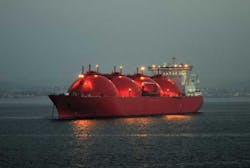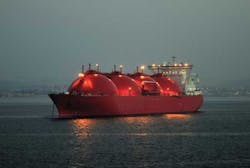Australia’s coming LNG boom
The Land Down Under could displace Qatar as the top LNG exporter in the world by 2020
Article from the Economist Intelligence Unit
The International Energy Agency speculates that we could be entering a "golden age of gas. If that is the case, Australia is set to be a key contributor to it. While much attention has been paid to the shale gas boom in North America and prospects for the spread of the "shale gas revolution elsewhere, Australia has been positioning itself to emerge as a leading player in the global liquefied natural gas (LNG) market by the end of this decade.
Australia could even displace Qatar as the top LNG exporter in the world by 2020. At the very least, Australia will surpass major LNG exporters Indonesia and Malaysia in terms of total liquefaction capacity. This will enable Australia, an already well-established Asia-Pacific LNG supplier, to carve out a greater role in the global LNG trade.
Gas production and LNG operations are not new to Australia. But a gas-for-export sector, in the form of LNG, in the country is set to grow substantially. Australia’s growing role as an LNG exporter will be made possible by the further development of offshore conventional gas resources, and of coal seam gas (CSG).
A new report from the Economist Intelligence Unit (EIU) analyzes the dominant trends in the development of Australia’s gas resources and details the LNG projects that will unlock these resources for export to markets in Asia. The report also assesses the domestic and international drivers and constraints that will impact Australia’s ability to increase its LNG export capacity.
Despite Australia’s great LNG potential, several factors are likely to slow the pace of progress and determine how far the country’s LNG sector will expand after 2020. However, this much is clear: Australia is on the cusp of dramatically expanding its role as an LNG supplier to Asian markets this decade.
Australia and global gas supply
Australia has abundant resources of conventional and unconventional gas to supply both domestic and export markets. With 135 trillion cubic feet (tcf) in proved reserves, Australia is the 11th-largest holder of gas reserves in the world. Just under one-quarter of these reserves are unconventional coal seam gas (CSG) reserves. Australia has been exporting gas in the form of LNG for over 20 years, and future development of these reserves, both conventional offshore and CSG, will be increasingly directed towards supplying export markets.
Australia already supplying LNG to Asia
Australia has three LNG export plants operating, two in Western Australia and one in the Northern Territory, with total capacity of 24.3m tonnes/year (t/y). All three terminals source natural gas from offshore fields. In 2011 Australia was the fourth-largest LNG exporter by volume – behind Qatar, Malaysia, and Indonesia – accounting for 7.9% of global LNG exports. Japan accounted for 73.4% of Australia’s LNG exports and China for 19.3% in that year. The remainder was exported to South Korea, Taiwan, India, and the Middle East.
Australia is not the only supplier of LNG to the growing Asian gas market. Malaysia, Indonesia, Brunei, Oman, Nigeria, Qatar, and Russia (Sakhalin Island) are also established suppliers to the energy-hungry Asian economic giants. However, of these suppliers, Australia will initiate the largest increase in LNG export capacity in the coming years, and is poised to replicate the capacity growth that Qatar achieved during the previous decade.
Australia’s proximity to Asia provides its LNG export sector with a large and expanding market practically in its back yard. The EIU forecasts robust gas consumption growth in Asia, increasing the regional need for imported LNG. Operators of Australian LNG projects, both existing and planned, have underpinned their projects with longer-term supply agreements, which will guarantee supplies to Asian gas-consuming economies for several years.
The next wave of LNG: an Australian decade
The EIU expects Australia’s LNG exports to increase significantly during the second half of this decade, with seven LNG projects in the construction phase. The timing of some of these projects may be delayed to some extent because of higher than anticipated costs.
Approximately 61m t/y of LNG export capacity in Australia are scheduled to be added to Australia’s LNG capacity from these seven projects already approved. This includes 35.9m t/y from plants that will source conventional offshore gas fields in Western Australia and the Northern Territory, and 25.4m t/y that will source onshore CSG resources in Queensland.
If achieved, this will make Australia the largest global LNG exporter, assuming no further capacity increases from Qatar, the current LNG leader. Furthermore, Australia’s share of global LNG export capacity will sharply increase from around 8% in 2012.
A risky business
There are several risks facing Australia’s LNG sector. High project costs, scarce labor supply, a strengthened Australian dollar, infrastructure bottlenecks, and tight environmental regulations could combine to delay the timing of some LNG projects coming on stream. Australia is an expensive place to build an LNG plant. Domestic political risks include opposition from some farming communities to CSG-to-LNG projects, and demands from local industrial gas consumers to keep a certain portion of gas production for the Australian market.
North America and East Africa may emerge as potential competitors to Australia for the Asian LNG market in the longer term. In the case of US LNG, volumes are likely to be competitively priced as they will not be indexed to an average basket of crude oil prices in Asia. Nevertheless, if a flood of North American and East African LNG does occur it will impact the viability of proposed LNG projects in Australia that are unlikely to be sanctioned in the next few years. Australian LNG projects under construction already have long-term supply agreements in place.
Conclusion
Despite the domestic and international risks addressed in the report, the EIU expects the second half of this decade to be a significant one for the Australian LNG sector. By 2020 Australia will have a much greater role as a key supplier to the Asian LNG market.
Proximity, low political risk, and available resources will enable Australia to maintain a key role in supplying the Asian market, even accounting for North American and East African competition in the longer term; and even if Australia’s LNG capacity expands only modestly beyond the current list of seven projects that are currently under construction.
For more information, visit the Economist Intelligence Unit’s website at www.eiu.com/research.

